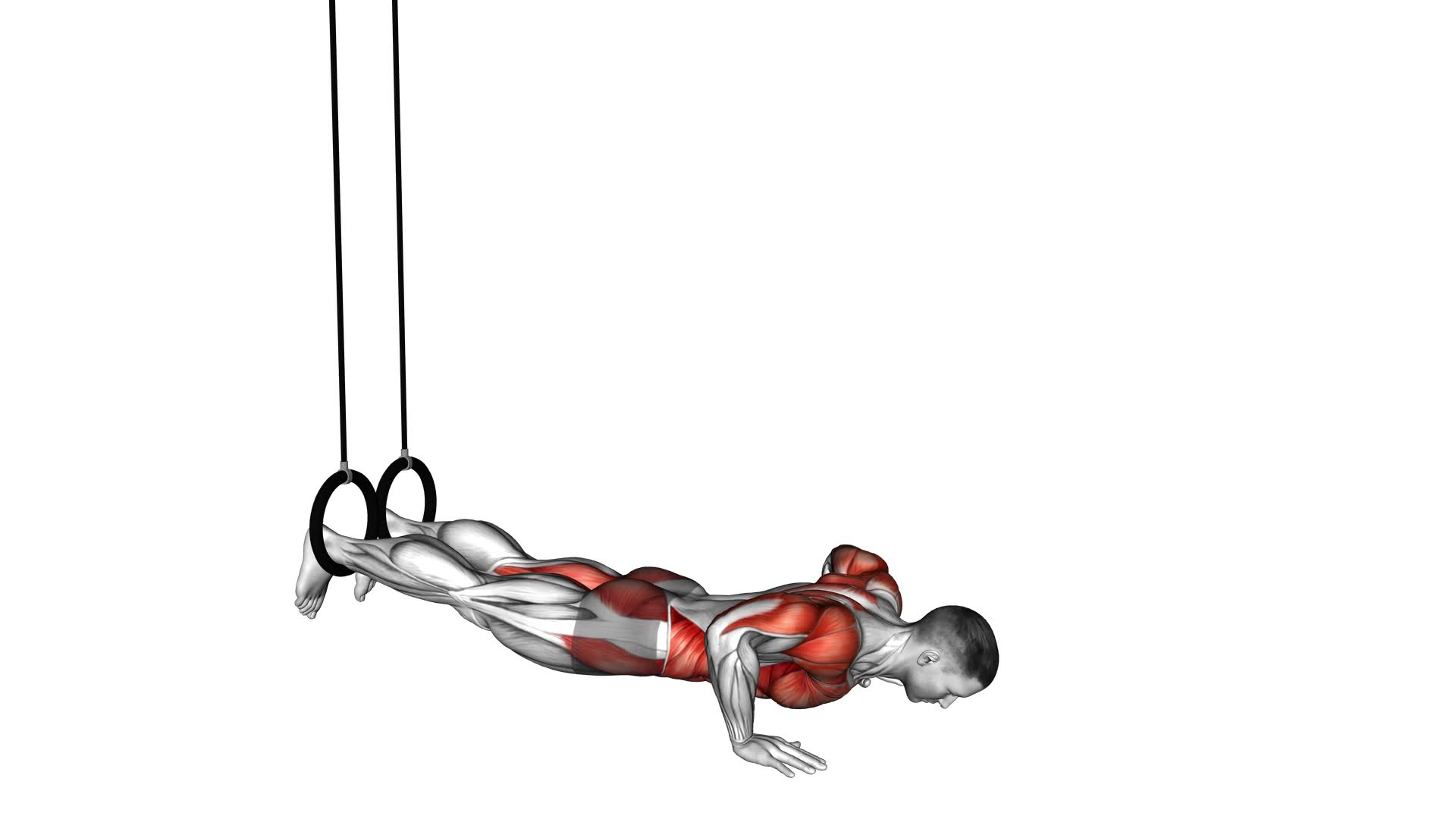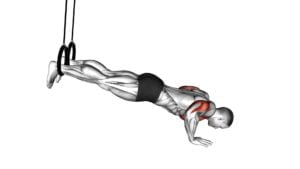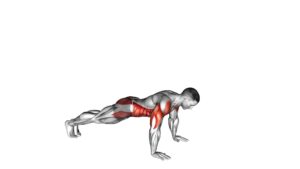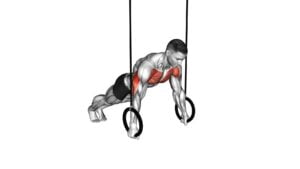Ring Push-up to Side Plank – Video Exercise Guide & Tips

Are you looking to step up your workout routine? Try the Ring Push-up to Side Plank! This dynamic exercise targets your chest, shoulders, and core, giving you a full-body burn.
Watch This Exercise Video
In this video exercise guide, we'll show you the proper form and technique, along with modifications and progressions for all fitness levels. Avoid common mistakes and get ready to maximize your workout with these helpful tips.
Let's get started!
Key Takeaways
- The Ring Push-up to Side Plank targets the chest, shoulders, and core muscles.
- It provides a more challenging and dynamic workout compared to traditional push-ups.
- The exercise activates multiple muscle groups simultaneously, enhancing overall strength and stability.
- Proper form and technique, including maintaining a strong and stable body position, are crucial for maximizing the benefits of this exercise.
Benefits of the Ring Push-up to Side Plank
You'll experience increased core strength and shoulder stability when performing the Ring Push-up to Side Plank exercise. This exercise is highly beneficial and offers a range of advantages for your workout routine.
Firstly, the Ring Push-up to Side Plank incorporates ring push up variations, which provide a more challenging and dynamic workout compared to traditional push-ups. By using rings instead of a stable surface, you engage more muscles in your upper body, including your chest, shoulders, and triceps.
Furthermore, the Ring Push-up to Side Plank activates multiple muscle groups simultaneously, leading to improved overall muscle activation and coordination. In particular, this exercise targets your core muscles, including the rectus abdominis, obliques, and transverse abdominis. As you transition from the push-up position to the side plank, you engage your obliques and hip muscles, promoting stability and balance.
Additionally, the Ring Push-up to Side Plank helps to enhance shoulder stability. As you stabilize your body on the rings, you engage the muscles around your shoulder joint, including the deltoids and rotator cuff muscles. This not only strengthens your shoulders but also helps to prevent injuries in this area.
Proper Form and Technique
To properly execute the Ring Push-up to Side Plank exercise, focus on maintaining a strong and stable body position throughout the movement.
Begin by placing the rings at a height that allows you to maintain a straight line from your head to your heels when in a push-up position. Keep your core engaged and your glutes squeezed to maintain stability.
As you lower yourself into a push-up, make sure to keep your elbows tucked in and your body in a straight line. Avoid dropping your hips or letting your lower back sag.
Once you reach the top of the push-up, shift your weight onto one hand and rotate your body into a side plank position. Keep your supporting arm locked out and your shoulder stacked over your wrist. Your body should form a straight line from your head to your heels.
Common errors to avoid include allowing your hips to sag or rotating your torso too far.
If you're having trouble with the full exercise, you can modify it by performing the push-up and side plank separately.
Variations of the exercise include adding a leg lift during the side plank or performing the exercise with your feet elevated on a bench.
Remember to listen to your body and adjust the exercise as needed to maintain proper form.
Modifications and Progressions
To modify or progress the Ring Push-up to Side Plank exercise, you can adjust the height of the rings or add additional challenges to increase the difficulty and intensity of the movement. There are several modifications that can be made to accommodate different fitness levels or to address specific limitations.
For beginners or those with limited upper body strength, you can start by performing the exercise with the rings set at a higher height. This reduces the amount of body weight you have to lift and makes it easier to maintain proper form. As you build strength and confidence, you can gradually lower the rings to increase the challenge.
To make the exercise more challenging, you can try advanced variations. One option is to add a push-up between each side plank. This increases the demand on your chest, shoulders, and triceps. Another option is to perform the exercise with one leg lifted off the ground, engaging your core and improving stability. You can also try performing the exercise with your feet elevated on a bench or stability ball, which further engages your stabilizer muscles.
Remember to progress gradually and listen to your body. It's important to maintain proper form and avoid pushing yourself too hard too soon. With consistent practice and proper modifications or progressions, you can continue to challenge yourself and improve your strength and stability.
Common Mistakes to Avoid
A common mistake to avoid when performing the Ring Push-up to Side Plank exercise is allowing your hips to sag or drop, compromising the stability and effectiveness of the movement. Proper technique is crucial for maximizing the benefits of this exercise and minimizing the risk of injury.
Another common mistake is having your elbows flare out to the sides during the push-up phase. This not only puts unnecessary strain on your shoulders, but it also reduces the engagement of your chest muscles. To avoid this, make sure to keep your elbows tucked in close to your body throughout the entire movement.
Additionally, rushing through the exercise is a common mistake that can compromise your form and hinder your progress. Take your time to perform each rep with control and precision, focusing on maintaining proper alignment and engaging the targeted muscles.
Lastly, neglecting to engage your core muscles during the side plank phase is another common mistake. Your core muscles play a crucial role in stabilizing your body and maintaining proper alignment. Remember to brace your core and actively contract your abdominal muscles throughout the entire exercise.
Tips for Maximizing Your Workout
Get the most out of your workout by incorporating these tips to maximize your results.
- Effective warm up exercises: Before diving into your workout, it's important to properly warm up your body. Dynamic stretching, such as leg swings and arm circles, can help increase your range of motion and prevent injuries. Additionally, incorporating cardio exercises like jogging or jumping jacks can get your heart rate up and prepare your muscles for the workout ahead.
- Incorporating resistance bands into your workout: Resistance bands are a versatile and affordable tool that can take your workout to the next level. They provide constant tension throughout the exercise, helping to build strength and improve muscle definition. Whether you're using them for bicep curls, squats, or shoulder presses, resistance bands can add an extra challenge to your routine.
- Alternating high-intensity intervals: If you're looking to maximize your workout and burn more calories, try incorporating high-intensity intervals. This involves alternating periods of intense exercise with short recovery periods. For example, you could sprint for 30 seconds and then walk for 60 seconds. This type of training can help boost your metabolism and improve cardiovascular fitness.
By implementing these tips, you can optimize your workout routine and achieve better results. Remember to always listen to your body and adjust the intensity and duration of your workouts accordingly.
Happy exercising!
Frequently Asked Questions
How Long Should I Hold the Side Plank Position During the Exercise?
To determine how long you should hold the side plank position during the exercise, it's important to consider your fitness level and goals. Beginners may start with shorter holds, around 10-15 seconds, gradually increasing as they build strength and stability.
Advanced athletes can aim for longer holds, anywhere from 30-60 seconds or more. Remember to listen to your body and adjust the duration based on your comfort and progression.
Can I Do the Ring Push-Up to Side Plank Exercise if I Have a Shoulder Injury?
If you have a shoulder injury, it's important to avoid exercises that could worsen your condition. Instead of the ring push-up to side plank, try alternative shoulder exercises that are less stressful on the joints, such as seated dumbbell shoulder press or resistance band lateral raises.
Always consult with a healthcare professional or a qualified trainer for modifications and guidance specific to your injury. Safety and proper form should be prioritized to prevent further damage.
Is It Necessary to Have a Set of Rings to Perform This Exercise, or Can I Use Other Equipment?
You don't necessarily need rings to perform the ring push-up to side plank exercise. There are alternative equipment options you can use, such as TRX straps or parallettes.
Incorporating the ring push-up to side plank in your workout routine has several benefits. It helps strengthen your shoulders, chest, core, and stabilizer muscles. This exercise also improves balance, coordination, and overall upper body strength.
How Often Should I Include the Ring Push-Up to Side Plank Exercise in My Workout Routine?
To determine how often to include the ring push-up to side plank exercise in your workout routine, consider your workout frequency and exercise intensity.
The frequency of this exercise depends on your fitness goals and overall program. If you're looking to challenge your upper body and core, aim to perform this exercise 2-3 times per week.
However, if you're focusing on other muscle groups or have a more intense workout routine, you may choose to include it less frequently.
Are There Any Variations of the Ring Push-Up to Side Plank That Target Specific Muscle Groups More Effectively?
When it comes to the ring push-up to side plank exercise, there are indeed variations that can target specific muscle groups more effectively.
By modifying the positioning of your hands or feet, you can focus on different areas such as the chest, shoulders, or core.
These variations can help you achieve a more well-rounded workout and target specific muscle groups based on your goals.
Conclusion
Incorporating the ring push-up to side plank exercise into your workout routine can provide numerous benefits. This exercise can help improve upper body and core strength, stability, and balance. It is important to maintain proper form and technique while performing this exercise. This includes keeping your body in a straight line, engaging your core, and using controlled movements. Additionally, you can modify or progress the exercise as needed to suit your fitness level. For example, you can start with a modified version of the exercise by performing it on your knees instead of your toes. As you get stronger, you can progress to performing the exercise on your toes. Finally, it is important to avoid common mistakes when performing this exercise. These mistakes include sagging your hips or letting your shoulders round forward. By avoiding these mistakes and focusing on proper form, you can maximize the effectiveness of the exercise. If you have any concerns or questions about incorporating this exercise into your fitness routine, it is always a good idea to consult with a fitness professional.

Author
Years ago, the spark of my life’s passion ignited in my mind the moment I stepped into the local gym for the first time. The inaugural bead of perspiration, the initial endeavor, the very first surge of endorphins, and a sense of pride that washed over me post-workout marked the beginning of my deep-seated interest in strength sports, fitness, and sports nutrition. This very curiosity blossomed rapidly into a profound fascination, propelling me to earn a Master’s degree in Physical Education from the Academy of Physical Education in Krakow, followed by a Sports Manager diploma from the Jagiellonian University. My journey of growth led me to gain more specialized qualifications, such as being a certified personal trainer with a focus on sports dietetics, a lifeguard, and an instructor for wellness and corrective gymnastics. Theoretical knowledge paired seamlessly with practical experience, reinforcing my belief that the transformation of individuals under my guidance was also a reflection of my personal growth. This belief holds true even today. Each day, I strive to push the boundaries and explore new realms. These realms gently elevate me to greater heights. The unique combination of passion for my field and the continuous quest for growth fuels my drive to break new ground.







